案例研究:设计与方法(修改版本)
- 格式:ppt
- 大小:484.00 KB
- 文档页数:45
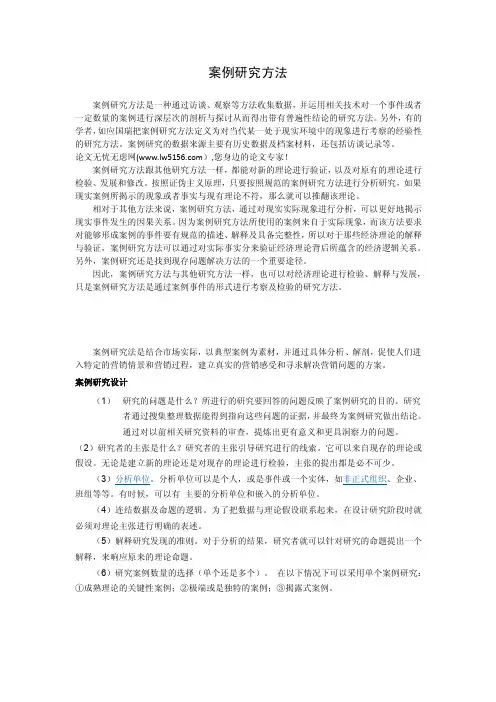
案例研究方法案例研究方法是一种通过访谈、观察等方法收集数据,并运用相关技术对一个事件或者一定数量的案例进行深层次的剖析与探讨从而得出带有普遍性结论的研究方法。
另外,有的学者,如应国瑞把案例研究方法定义为对当代某一处于现实环境中的现象进行考察的经验性的研究方法。
案例研究的数据来源主要有历史数据及档案材料,还包括访谈记录等。
论文无忧无虑网(),您身边的论文专家!案例研究方法跟其他研究方法一样,都能对新的理论进行验证,以及对原有的理论进行检验、发展和修改。
按照证伪主义原理,只要按照规范的案例研究方法进行分析研究,如果现实案例所揭示的现象或者事实与现有理论不符,那么就可以推翻该理论。
相对于其他方法来说,案例研究方法,通过对现实实际现象进行分析,可以更好地揭示现实事件发生的因果关系。
因为案例研究方法所使用的案例来自于实际现象,而该方法要求对能够形成案例的事件要有规范的描述、解释及具备完整性,所以对于那些经济理论的解释与验证,案例研究方法可以通过对实际事实分来验证经济理论背后所蕴含的经济逻辑关系。
另外,案例研究还是找到现存问题解决方法的一个重要途径。
因此,案例研究方法与其他研究方法一样,也可以对经济理论进行检验、解释与发展,只是案例研究方法是通过案例事件的形式进行考察及检验的研究方法。
案例研究法是结合市场实际,以典型案例为素材,并通过具体分析、解剖,促使人们进入特定的营销情景和营销过程,建立真实的营销感受和寻求解决营销问题的方案。
案例研究设计(1)研究的问题是什么?所进行的研究要回答的问题反映了案例研究的目的。
研究者通过搜集整理数据能得到指向这些问题的证据,并最终为案例研究做出结论。
通过对以前相关研究资料的审查,提炼出更有意义和更具洞察力的问题。
(2)研究者的主张是什么?研究者的主张引导研究进行的线索。
它可以来自现存的理论或假设。
无论是建立新的理论还是对现存的理论进行检验,主张的提出都是必不可少。
班组等等。
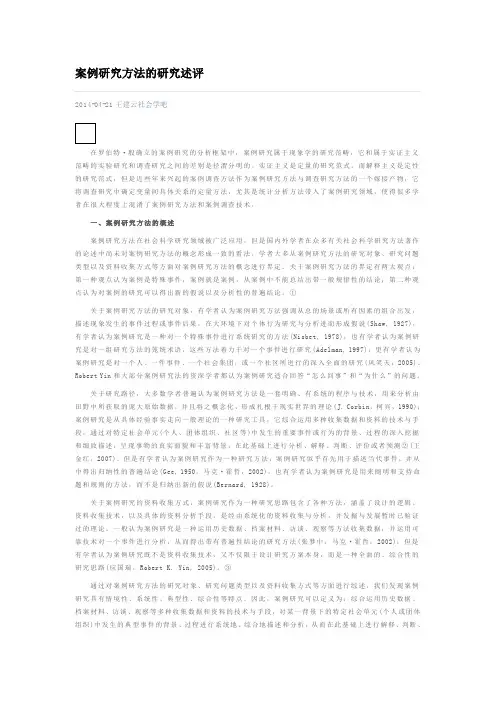
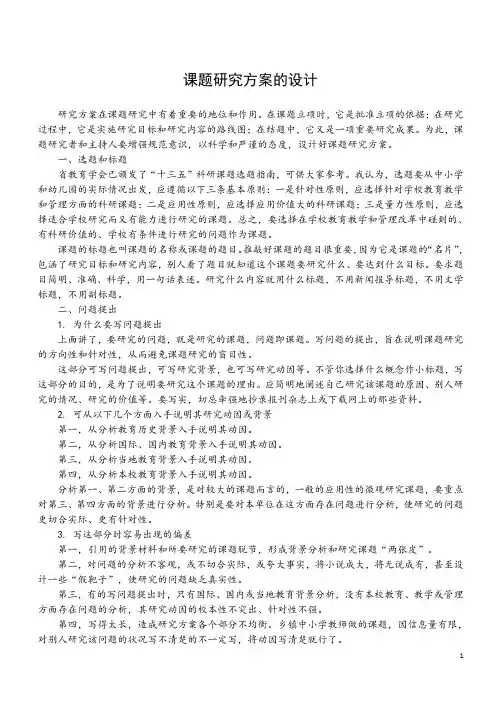
课题研究方案的设计研究方案在课题研究中有着重要的地位和作用。
在课题立项时,它是批准立项的依据;在研究过程中,它是实施研究目标和研究内容的路线图;在结题中,它又是一项重要研究成果。
为此,课题研究者和主持人要增强规范意识,以科学和严谨的态度,设计好课题研究方案。
一、选题和标题省教育学会已颁发了“十三五”科研课题选题指南,可供大家参考。
我认为,选题要从中小学和幼儿园的实际情况出发,应遵循以下三条基本原则:一是针对性原则,应选择针对学校教育教学和管理方面的科研课题;二是应用性原则,应选择应用价值大的科研课题;三是量力性原则,应选择适合学校研究而又有能力进行研究的课题。
总之,要选择在学校教育教学和管理改革中碰到的、有科研价值的、学校有条件进行研究的问题作为课题。
课题的标题也叫课题的名称或课题的题目。
推敲好课题的题目很重要,因为它是课题的“名片”,包涵了研究目标和研究内容,别人看了题目就知道这个课题要研究什么、要达到什么目标。
要求题目简明、准确、科学,用一句话表述。
研究什么内容就用什么标题,不用新闻报导标题,不用文学标题,不用副标题。
二、问题提出1. 为什么要写问题提出上面讲了,要研究的问题,就是研究的课题,问题即课题。
写问题的提出,旨在说明课题研究的方向性和针对性,从而避免课题研究的盲目性。
这部分可写问题提出,可写研究背景,也可写研究动因等。
不管你选择什么概念作小标题,写这部分的目的,是为了说明要研究这个课题的理由。
应简明地阐述自己研究该课题的原因、别人研究的情况、研究的价值等。
要写实,切忌牵强地抄录报刊杂志上或下载网上的那些资料。
2. 可从以下几个方面入手说明其研究动因或背景第一,从分析教育历史背景入手说明其动因。
第二,从分析国际、国内教育背景入手说明其动因。
第三,从分析当地教育背景入手说明其动因。
第四,从分析本校教育背景入手说明其动因。
分析第一、第二方面的背景,是对较大的课题而言的,一般的应用性的微观研究课题,要重点对第三、第四方面的背景进行分析。
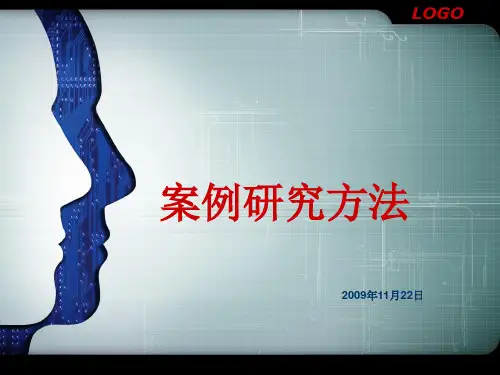
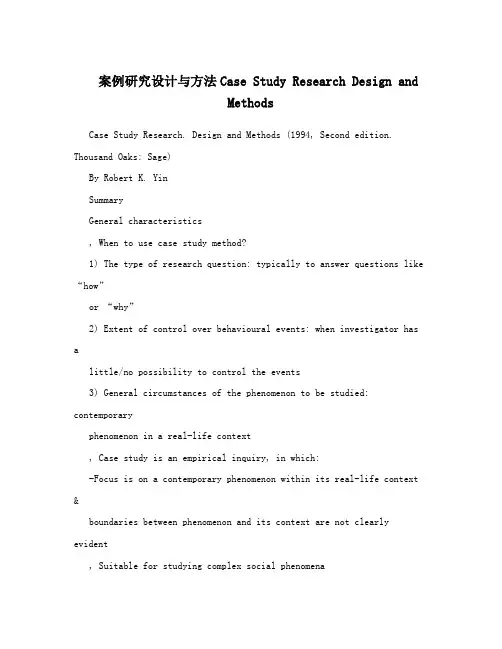
案例研究设计与方法Case Study Research Design andMethodsCase Study Research. Design and Methods (1994, Second edition. Thousand Oaks: Sage)By Robert K. YinSummaryGeneral characteristics, When to use case study method?1) The type of research question: typically to answer questions like “how”or “why”2) Extent of control over behavioural events: when investigator hasalittle/no possibility to control the events3) General circumstances of the phenomenon to be studied: contemporaryphenomenon in a real-life context, Case study is an empirical inquiry, in which:-Focus is on a contemporary phenomenon within its real-life context &boundaries between phenomenon and its context are not clearly evident, Suitable for studying complex social phenomena-Procedural characteristics in the situation include: Many variables ofinterest; multiple sources of evidence; theoretical propositions to guide thecollection and analysis of data-Types of case studies might be: explanatory; exploratory; descriptive-Designs can be single- or multiple-case studies-Used methods can be qualitative, quantitative, or both, Typical criticisms towards case studies & correcting answers: -Lack of systematic handling of data -> Systematic reporting of all evidence-No basis for scientific generalization -> Purpose is to generalize to theoreticalpropositions, not to population as in statistical research-Take too long, end up with unreadable documents -> Time limits & writingformula depend on the choices of investigatorsCase study research design, Central components of a case study design & their functions:1) A study’s questions –“how”, “why”2) Study’s (theoretical) propositions – pointing attention, limiting scope,suggesting possible links between phenomena3) Study’s units of analysis – main units must be at the samelevel as thestudy questions & typically comparable to those previously studied4) Logic linking the data to the propositions – matching pieces ofinformation to rival patterns that can be derived from the propositions5) Criteria for interpreting the findings – iteration between propositionsand data, matching sufficiently contrasting rival patterns to data; thereis no precise way of setting the criteria1Research design links the data to be collected and conclusions to be drawn to theinitial questions of the study – it provides a conceptual framework & an action planfor getting from questions to set of conclusions., Preliminary theory & blueprint of the study: having solved thefive stepsmentioned above leads to the formation of a loose theory & a blueprint relatedto the topic of study-Initial theory & understanding of what is being studied is necessarybefore any field contacts; the complete research design embodies a “theory”of what is being studied, Deciding between explanatory, exploratory and descriptive designs: -Depends on the richness of the rival propositions in theoriesrelated to thetopic of the study; richest theories allow explanatory designs-> Search for theoretical propositions that can be elaborated to cover studyquestions, propositions, units of analysis, data-proposition links & criteria ofinterpretation-> Reviewing literature, discussing with investigators, asking challengingquestions, thinking what is to be learned from the study-> Being aware of the range of theories & selecting the requiredlevel(individual, organization, societal)-> Construction of the design / conceptual framework takes time &can bedifficult, but is a crucial step for the success of the study, Selection of the cases:-Cases should be selected in the same way as the topic of an experiment isselected-> Developed preliminary theory is used as a template with which to comparethe characteristics & empirical findings from the case(s)-> Selected cases should reflect characteristics & problems identified in theunderlying theoretical propositions / conceptual framework, The level of generalization of the study results = appropriately developedpreliminary theory / study design-Mode of generalization = theory-related analytic generalization, notstatistical-Analytic generalization possible from one or more casesHOW MANY OF CASES & UNITS OF ANALYSIS?1) Case – represents somehow the interesting topic of the study empirically (e.g.the role of the United States in the world economy) 2) Unit of analysis – is the actual source of information: individual, organizational document, artifact, for example (e.g. the capital flow betweencountries, an economic policy)1) Cases:A) Single cases – if case seems to represent a critical test to existing theory;rare or unique events -> Important to select case & unit of analysis properly2B) Multiple cases –if a “replication logic” is supposed to reveal support for theoreticallyi. Similar resultsii. Contrasting results for predictable reasons-> Theoretical framework must identify clearly the conditions, when aparticular phenomenon is likely to be found (i.) and when it is not likely (ii.)-> Theoretical framework is the vehicle for generalizing to new cases; ifempirical cases do not work as predicted, modifications must be made to thetheory-> Number of case replications depends upon the certainty wanted to achieve& richness of the underlying theoretical propositions2) Units of analysis:A) Holistic designs – include a single unit of analysis; if aim is to study the global nature of the phenomenon; when no logical sub-units can be pointed ->danger of abstractnessB) Embedded designs – include multiple units of analysis; study may includemain & smaller units on different levels -> looking for consistent patterns ofevidence across units, but within a case, Note: The flexibility of case study design is in selecting cases different fromthose initially identified, not in changing the purpose or objectives of thestudy to suit the casesConducting case studies, Desired skills of the investigator:-Good knowledge of the phenomenon (->collection procedures are not routinized)-Sensitivity for novel & unexpected issues in data collection-Asking good questions-Being a good “listener” -Adaptiveness & flexibility, A case study protocol should be essential part of every case study project - A protocol contains the instrument for the research, but also the proceduresand general rules that shoud be followed using the instrument:- Overview of the study project (objectives, issues, readings,literature & research)- Field procedures (access to field sites, sources of information) - Case study questions posed to INVESTIGATORS; keyclassifications; suggestions for likely sources of evidence (not the literal questions to be asked)- A guide for the case study report- Note: Case study protocol should be co-authored by all study investigators, Important to identify different levels of questions:A) Single case -level1. Questions asked of specific interviewees32. Questions asked of the individual caseB) More general levels1. Findings across multiple cases2. Findings across an entire study (including reviewed literature)3. Normative questions about policy recommendations & conclusions, Sometimes a pilot study may provide useful helpCollecting the evidence, Six sources of evidence:1) Documents (letters, agendas, progress reports)2) Archival records (Service records, organizational charts, budgets etc.)3) Interviews (typically open-ended, but also focused, structured &surveys are possible)4) Direct observations (formal or casual; useful to have multipleobservers)5) Participant observation (assuming a role in the situation &getting aninside view of the events)6) Physical artefacts, Three principles of data collection:1) Use multiple sources of evidence-Triangulation = searching converging findings from differentsources ->increases construct validity2) Create a case study database-A database separate from the final report to be written, containing - Case study notes (clear & available for later use)- Case study documents- Tabular materials (collected & created)- Narratives (initial open-ended answers to the study questionssuggested by investigators)3) Maintain a chain of evidence-> The link between initial study questions and case study procedureshould be pointed out in the case study protocol, as also the circumstancesof the evidence to be collected-> Putting the data collection to practice on the basis of the protocol-> Actual evidence storage in the database for later checks (specificcollection circumstances indicated)-> Sufficient citing of the case study data base & evidence in the finalreport and conclusions to be drawnAnalysing the evidenceAnalysis of evidence is one the least developed and most difficult aspects of doingcase studies. Most important is to have a general analytic strategy, which helps tochoose among different techniques. In absence preliminarytechniques – matrixes,4tabulation of frequencies, temporal schemes etc. – can be tried out to get the analysisstarted., Two general analytic strategies:1) Relying on theoretical propositions: theoretical orientation guidingthe analysis; following theoretical propositions that have formed thedesign of the case study -> helps to focus attention on certain data &to ignore other data2) Developing a case description: a descriptive framework fororganizing the case study; analysis organized on the basis ofdescription of the general characteristics and relations of the phenomenon in question, Analytic techniques to be used as part of the general strategy:1) Pattern matching (explanatory / descriptive)-Comparing empirically based patterns with predicted one(s)a) Expected outcomes as a pattern: comparing if theinitially predicted results have been found andalternative patterns are absentb) Rival explanations as patterns: searching if some of thetheoretically salient explaining conditions might bearticulated in empirical findings; then the presence ofcertain explanation should exclude the presence ofothersc) Simpler patterns: pattern matching is possible also withonly few variables, if the derived patterns are predictedto have enough clear differences2) Explanation-building (mainly explanatory)-Analyzing case study data by building an explanation about the case & identifying a set of causal links-Explanation is a result of series of iterations:Initial theoretical statement -> Comparing findings of an initial case ->revising statement -> Comparing details of the case -> Revising -> Comparing to other additional cases-Note: Danger of drifting away from original topic of interest3) Time-series analysis-“How”- and “why”- questions about relationships & changes of events over time-Identifying theoretically proposed sequences of an event that are expected to lead to a certain outcome; identification of events must bedone before the onset of the investigation->Comparing this trend with the trend of empirical data points -> Comparing with some rival trend to rule alternatives out, Analysis should show that:It relied on all the relevant evidence; all major rival interpretations are dealt;most significant issue of the study is addressed; prior expert knowledge isbrought to the study 5。
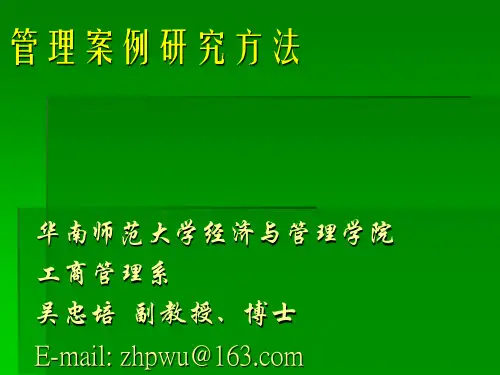
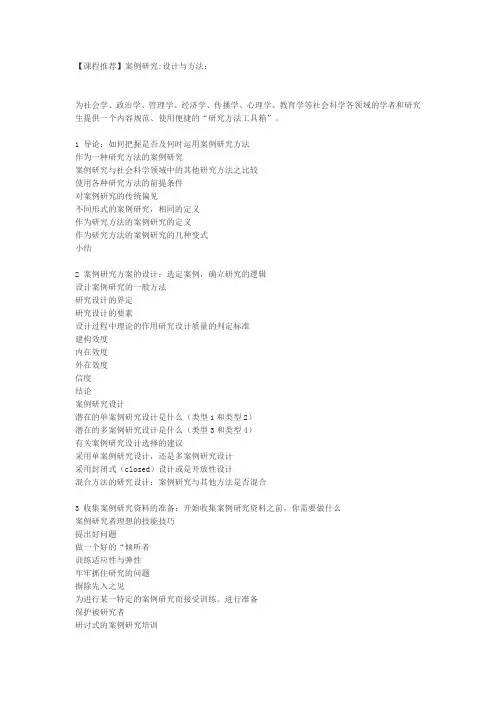
【课程推荐】案例研究:设计与方法:为社会学、政治学、管理学、经济学、传播学、心理学、教育学等社会科学各领域的学者和研究生提供一个内容规范、使用便捷的“研究方法工具箱”。
1 导论:如何把握是否及何时运用案例研究方法作为一种研究方法的案例研究案例研究与社会科学领域中的其他研究方法之比较使用各种研究方法的前提条件对案例研究的传统偏见不同形式的案例研究,相同的定义作为研究方法的案例研究的定义作为研究方法的案例研究的几种变式小结2 案例研究方案的设计:选定案例,确立研究的逻辑设计案例研究的一般方法研究设计的界定研究设计的要素设计过程中理论的作用研究设计质量的判定标准建构效度内在效度外在效度信度结论案例研究设计潜在的单案例研究设计是什么(类型1和类型2)潜在的多案例研究设计是什么(类型3和类型4)有关案例研究设计选择的建议采用单案例研究设计,还是多案例研究设计采用封闭式(closed)设计或是开放性设计混合方法的研究设计:案例研究与其他方法是否混合3 收集案例研究资料的准备:开始收集案例研究资料之前,你需要做什么案例研究者理想的技能技巧提出好问题做一个好的“倾听者训练适应性与弹性牢牢抓住研究的问题摒除先入之见为进行某一特定的案例研究而接受训练、进行准备保护被研究者研讨式的案例研究培训制订研究草案发现问题案例研究草案审查、评估案例研究项目实地研究(procedure)程序需要研究的问题指导撰写研究报告为你的研究筛选候选案例试验性案例研究选择试验性案例试验研究中的提问范围撰写试验性研究报告小结4 收集案例研究资料:从六种来源获取证据时所要遵守的一些原则六种证据来源文件档案记录访谈直接观察参与性观察实物证据资料收集的三大原则原则1:使用多种证据来源原则2:建立案例研究资料库原则3:形成一系列证据链小结5 案例研究的证据分析:怎样开始分析?选择哪些分析策略?这些策略的效果如何?分析策略:不仅仅是熟悉证据分析工具分析策略的必要性四种主要策略五种分析技术模式匹配建构性解释时序分析逻辑模型跨案例聚类分析确保高质量的分析小结6 撰写案例研究报告:写什么和怎么写确立研究报告的目标案例研究的交流案例研究报告要以读者需求为导向案例研究报告的书面格式作为大型、多种方法研究组成部分之一的案例研究报告案例研究报告的例证性结构线性分析式结构比较式结构时间顺序结构理论建构式结构悬念式结构无序(混合)结构撰写案例研究报告的步骤何时以及如何开始撰写案例的性质:真实的还是匿名的案例研究报告初稿的检查:确认程序示范性案例研究的特征有哪些案例研究必须要有价值案例研究必须“完整案例研究必须考虑不同的观点案例研究必须具有充实的依据必须以吸引读者的方式编写案例研究报告推荐教材:案例研究:设计与方法(中文第2版)定价:¥25.00作者:罗伯特·K.殷(Robert K.Yin)出版社:重庆大学出版社出版时间:2010年10月1日商品标识:asinB004FTBNXK版次:第2版印刷时间:2010年10月1日开本:32/BFEEDE88000000000401000003BA41B0。
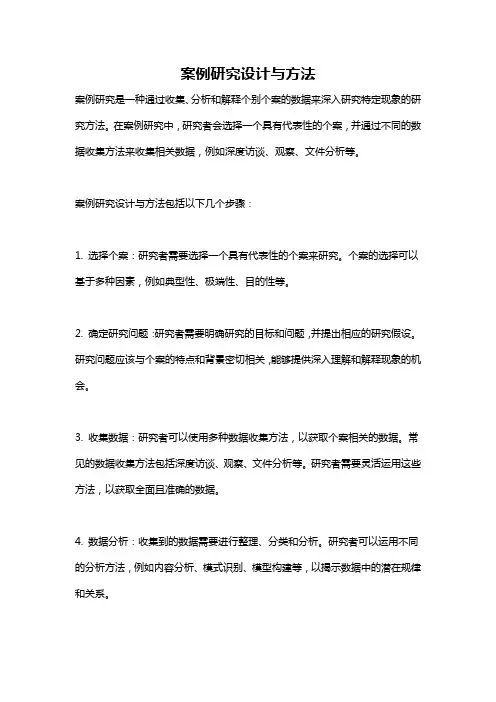
案例研究设计与方法案例研究是一种通过收集、分析和解释个别个案的数据来深入研究特定现象的研究方法。
在案例研究中,研究者会选择一个具有代表性的个案,并通过不同的数据收集方法来收集相关数据,例如深度访谈、观察、文件分析等。
案例研究设计与方法包括以下几个步骤:1. 选择个案:研究者需要选择一个具有代表性的个案来研究。
个案的选择可以基于多种因素,例如典型性、极端性、目的性等。
2. 确定研究问题:研究者需要明确研究的目标和问题,并提出相应的研究假设。
研究问题应该与个案的特点和背景密切相关,能够提供深入理解和解释现象的机会。
3. 收集数据:研究者可以使用多种数据收集方法,以获取个案相关的数据。
常见的数据收集方法包括深度访谈、观察、文件分析等。
研究者需要灵活运用这些方法,以获取全面且准确的数据。
4. 数据分析:收集到的数据需要进行整理、分类和分析。
研究者可以运用不同的分析方法,例如内容分析、模式识别、模型构建等,以揭示数据中的潜在规律和关系。
5. 解读和解释:在分析数据的基础上,研究者需要解读和解释数据的含义和意义。
这包括对个案的特点、背景和行为进行解读,从而为现象提供更深入的理解和解释。
6. 结果呈现:研究者需要将研究结果进行呈现和展示。
这可以通过撰写研究报告、制作图表和表格等形式来完成。
研究结果应该明确、简洁、具有说服力,并与研究问题和目标保持一致。
案例研究设计与方法的主要特点是能够提供详细和深入的描述和解释,适用于复杂和多样的实际情况。
它能够突破常规的统计分析框架,探索特定个案的独特性和复杂性。
不过,由于个案的选择和数据收集方法的灵活性,案例研究的结果在一定程度上受到研究者主观因素的影响,因此需要在结果解释和推论时进行慎重考虑。
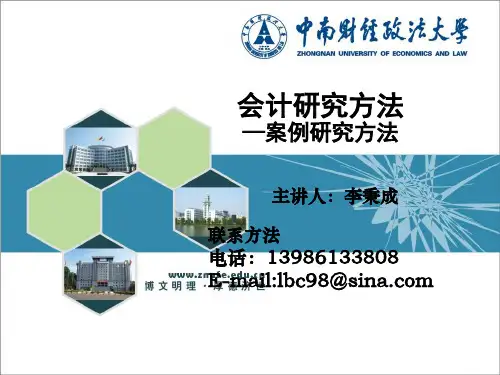
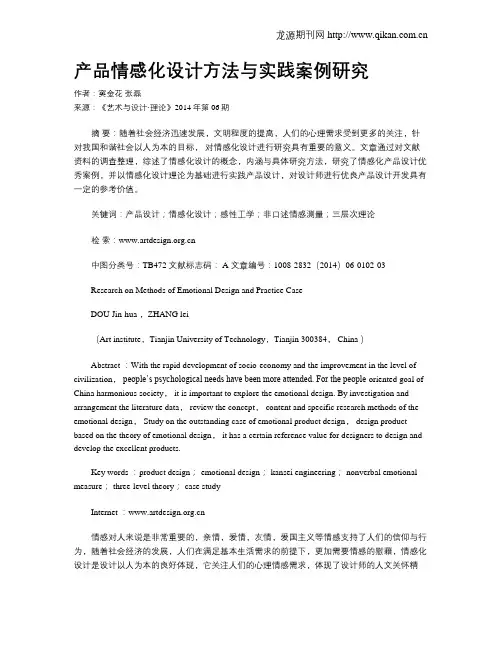
产品情感化设计方法与实践案例研究作者:窦金花张磊来源:《艺术与设计·理论》2014年第06期摘要:随着社会经济迅速发展,文明程度的提高,人们的心理需求受到更多的关注,针对我国和谐社会以人为本的目标,对情感化设计进行研究具有重要的意义。
文章通过对文献资料的调查整理,综述了情感化设计的概念,内涵与具体研究方法,研究了情感化产品设计优秀案例,并以情感化设计理论为基础进行实践产品设计,对设计师进行优良产品设计开发具有一定的参考价值。
关键词:产品设计;情感化设计;感性工学;非口述情感测量;三层次理论检索:中图分类号:TB472 文献标志码: A 文章编号:1008-2832(2014)06-0102-03Research on Methods of Emotional Design and Practice CaseDOU Jin-hua ,ZHANG lei(Art institute,Tianjin University of Technology,Tianjin 300384, China )Abstract :With the rapid development of socio-economy and the improvement in the level of civilization,people’s psychological needs have been more attended. For the people-oriented goal of China harmonious society, it is important to explore the emotional design. By investigation and arrangement the literature data, review the concept, content and specific research methods of the emotional design, Study on the outstanding case of emotional product design, design product based on the theory of emotional design, it has a certain reference value for designers to design and develop the excellent products.Key words :product design; emotional design; kansei engineering; nonverbal emotional measure; three-level theory; case studyInternet :情感对人来说是非常重要的,亲情,爱情,友情,爱国主义等情感支持了人们的信仰与行为,随着社会经济的发展,人们在满足基本生活需求的前提下,更加需要情感的慰藉,情感化设计是设计以人为本的良好体现,它关注人们的心理情感需求,体现了设计师的人文关怀精神。
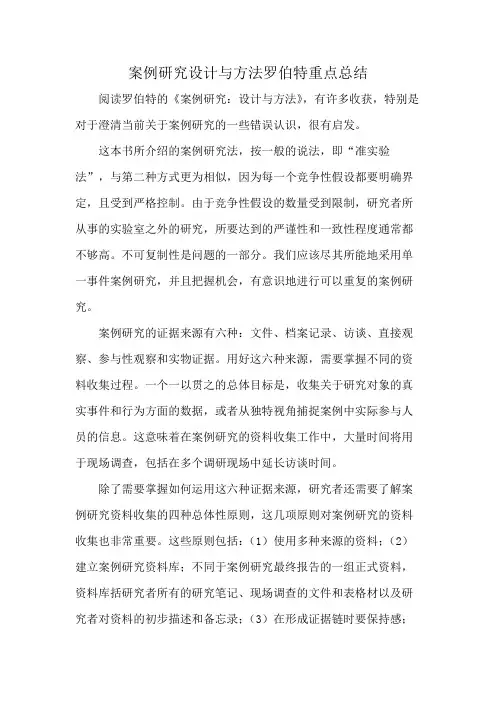
案例研究设计与方法罗伯特重点总结阅读罗伯特的《案例研究:设计与方法》,有许多收获,特别是对于澄清当前关于案例研究的一些错误认识,很有启发。
这本书所介绍的案例研究法,按一般的说法,即“准实验法”,与第二种方式更为相似,因为每一个竞争性假设都要明确界定,且受到严格控制。
由于竞争性假设的数量受到限制,研究者所从事的实验室之外的研究,所要达到的严谨性和一致性程度通常都不够高。
不可复制性是问题的一部分。
我们应该尽其所能地采用单一事件案例研究,并且把握机会,有意识地进行可以重复的案例研究。
案例研究的证据来源有六种:文件、档案记录、访谈、直接观察、参与性观察和实物证据。
用好这六种来源,需要掌握不同的资料收集过程。
一个一以贯之的总体目标是,收集关于研究对象的真实事件和行为方面的数据,或者从独特视角捕捉案例中实际参与人员的信息。
这意味着在案例研究的资料收集工作中,大量时间将用于现场调查,包括在多个调研现场中延长访谈时间。
除了需要掌握如何运用这六种证据来源,研究者还需要了解案例研究资料收集的四种总体性原则,这几项原则对案例研究的资料收集也非常重要。
这些原则包括:(1)使用多种来源的资料;(2)建立案例研究资料库;不同于案例研究最终报告的一组正式资料,资料库括研究者所有的研究笔记、现场调查的文件和表格材以及研究者对资料的初步描述和备忘录;(3)在形成证据链时要保持感;(4)使用电子资料源时要小心谨慎。
把这些原则综合运用到案例研究中,能进一步提高研究。
不管是以书面的形式,还是口头形式,分享研究结论意味着要公开呈现研究结果和研究发现。
无论报告的具体形式如何,写作都沿着一些类似的步骤:摸清报告的读者,安排写作结构,由他人修改草稿。
除了这些常规程序,也有其他报告撰写建议。
比如,关于案例研究报告的写作格式的建议:线性分析比较、时间顺序、理论建构、“悬念式”及不注重顺序的无序结构等。
不论是把案例研究看作一项完成了的研究,还是运用多种方法进行的研究的一部分,撰写案例研究报告是案例研究中最有价值的环节之一。
---------------------------------------------------------------最新资料推荐------------------------------------------------------案例研究与案例研究方法案例研究方法案例研究案例研究方法案例研究与案例研究方法余菁内容提要:本文阐述了人们对案例研究及案例研究方法的已有认识;区分了不同的案例研究类型;分析了案例研究方法在管理科学领域的应用、发展及趋势。
笔者认为,案例研究总体上处于其发展的初级阶段。
而管理学、尤其是企业管理学为案例研究这样一种经验性、贴近现实的研究方法,提供了发展和繁荣的沃土。
案例研究方法的内涵与外延,将伴随着案例研究自身的发展及其应用学科的发展而不断发展。
关键词:案例研究案例研究方法经验主义一、案例研究在社会科学领域,进行案例研究(Case Study)的文章已经很多了,但真正清楚案例研究的含义的人并不多。
长期以来,不同领域的研究者们对案例研究持有不尽相同的认识。
1984 年,罗伯特 K. 尹(Robert K. Yin)为案例研究给出了一个经典定义,即:案例研究是一种经验主义的探究(Empirical Inquiry),它研究现实生活背景中的暂时现象(Contemporary Phenomenon);在1 / 15这样一种研究情境中,现象本身与其背景之间的界限不明显,(研究者只能)大量运用事例证据(Evidence)来展开研究。
围绕这一定义及尹、罗伯特 E 斯特克(Robert E. Stake)等学者确立的案例研究的分析框架,人们开始逐步就案例研究的性质、研究对象及其作用这类问题形成大体一致的判断。
这些共识可以概括为 4 点:首先,案例研究是一种经验性的研究,而不是一种纯理论性的研究。
案例研究的意义在于回答是为什么和怎么样的问题(Yin,1994; Stake, 2019),而不是回答应该是什么的问题。
中学地理教学设计与案例研究7篇中学地理教学设计与案例研究7篇当我们对人生或者事物有了新的思考时,总结能让人的目标更加明确,教案整个教学资源的设计遵循实验探究教学模式步骤,做好地理教案教学设计很重要。
下面小编给大家带来教案模板,希望对大家有所帮助。
中学地理教学设计与案例研究精选篇1李林浩是个活泼大方的小朋友,入园以来一向表现的很好,善于团结其他小朋友,从来未和其他小朋友大家吵闹过,但这个孩子的好奇心很强,凡事都想问个为什么。
元旦过后,他妈妈找到我说孩子不愿来上学,每一天早上都找出不想来上学的一大堆理由来。
我经过和家长的沟通,最终明白了他不想来上学的缘由。
原先是元旦前几天,李林浩小朋友早上高高兴兴的来上学,看到我后主动跟我打招呼,但由于当时正是孩子们来学校的时间,汽车鸣笛声,孩子们的笑声都响成一片,根本听不到他在跟我打招呼,他看到这种情景后以为教师不喜欢他,故意不理他,所以很悲痛,并且告诉了妈妈。
了解到情景后我主动向李林浩小朋友说明了情景,并向家长作了解释,期望家长和孩子能谅解。
幸运的是孩子和家长都很热情理解了我。
事后李林浩小朋友又恢复了往日的活泼和开朗。
经过这件事我认识到当教师必须要细心和认真,要研究到每个孩子和家长的心境,他们都期望被关注,不能忽视他们的感受。
中学地理教学设计与案例研究精选篇2大班的孩子从这个学期开始已经开始动笔书写了,我们让孩子书写的都是一些最简单的数字和字母,大部分的孩子握笔的姿势正确,书写也挺好的。
可是也有一部分的孩子不会握笔,书写不成行。
这部分孩子的爸爸、妈妈纷纷找到教师,问是不是孩子没有认真学,或者是孩子太笨了……我要对各位家长说,你们别着急!孩子的本事发展有快有慢。
大班的孩子刚刚开始书写,怎样能够一下子就给孩子下定论呢?这样,无疑回给孩子背上思想包袱,影响他的发展,给他以后的学习造成必须的障碍。
孩子的年龄仅有四、五岁,许多细微的动作做不好也是正常的,像书写的动作就是细微的动作,刚刚开始拿笔时,多少孩子不会啊!此刻看看不是都会了吗。
案例研究的设计与分析方法案例研究是一种常用的研究方法,广泛应用于社会科学领域。
通过对具体案例的深入研究和分析,可以揭示事物之间的关系、探究问题的成因和解决方案,并为理论的发展提供实证依据。
本文将介绍案例研究的设计与分析方法,帮助读者更好地进行案例研究。
一、案例研究的设计1. 选取合适的案例在进行案例研究时,首先需要选择合适的案例。
案例可以是个人、组织或社会现象等,但需要具备以下特点:充分代表性、有足够的信息可供研究、独特性高、以及对研究问题具有重要意义。
选取合适的案例是确保研究结果具有广泛适用性的重要步骤。
2. 收集案例相关的数据和材料在进行案例研究之前,需要收集案例相关的数据和材料。
数据可以是定量数据(如统计数字)或定性数据(如访谈记录、观察记录等),材料可以是文献、报道或档案等。
通过收集充分的数据和材料,可以有助于构建全面的案例分析。
3. 设计研究方案在进行案例研究时,需要设计研究方案。
研究方案包括研究目的、研究问题、研究对象、数据收集方法、数据分析方法等。
研究方案的设计应该能够回答研究问题,并保证数据的准确性和可靠性。
4. 选择适当的数据分析方法在进行案例研究时,需要选择适当的数据分析方法。
数据分析方法可以是定量分析方法(如统计分析、回归分析等)或定性分析方法(如内容分析、主题分析等)。
根据研究目的和研究问题的不同,选择合适的数据分析方法是进行案例研究的关键。
二、案例研究的分析方法1. 描述案例在进行案例研究分析时,首先需要描述案例的基本情况。
描述案例可以从案例的背景、发展过程、相关人物等方面进行,目的是帮助读者更好地了解案例并建立起对案例的整体印象。
2. 识别关键问题在案例研究分析中,需要识别关键问题,明确研究的重点和焦点。
关键问题可以是研究对象面临的困境、需要解决的挑战或者研究问题的核心。
通过识别关键问题,可以有针对性地进行深入研究和分析。
3. 分析案例在进行案例研究分析时,需要对案例进行深入分析。
案例研究:设计与方法(第3版)罗伯特・K・殷著周海涛主译李永贤张蘅参译重庆大学出版社图书在版编目(CIP)数据案例研究:设计与方法:第3版/(美)殷(Yin,R.K.)著;周海涛,李永贤,张蘅译.———重庆:重庆大学出版社,2004.11 (万卷方法)ISBN7-5624-3266-XⅠ.案...Ⅱ.①殷...②周...③李...④张...Ⅲ.社会科学—研究方法Ⅳ.C3中国版本图书馆CIP数据核字(2004)第099701号案例研究:设计与方法罗伯特・K・殷著周海涛主译李永贤张蘅参译责任编辑:崔祝版式设计:周晓责任校对:李定群责任印制:秦梅*重庆大学出版社出版发行出版人:张鸽盛社址:重庆市沙坪坝正街174号重庆大学(A区)内邮编:400030电话:(023)6510237865105781传真:(023)6510368665105565网址:ht tp://w 邮箱:fxk@.c n(市场营销部)全国新华书店经销重庆科情印务有限公司印刷*开本:890×12401/32印张:6.5字数:192千2004年11月第1版2004年11月第1次印刷印数:1—3000I SBN7-5624-3266-X定价:15.00元本书如有印刷、装订等质量问题,本社负责调换版权所有,请勿擅自翻印和用本书制作各类出版物及配套用书,违者必究。
目录…………………………………………………………1导论2………………………………作为一种研究思路的案例研究3………案例研究与社会科学领域中的其他研究方法之比较4…………………………不同形式的案例研究,相同的定义14…………………………………………………………总结19…………………………………………………………练习20…………………………………………2案例研究方案的设计22……………………………………设计案例研究的一般方法23研究设计质量的判定标准37………………………………………………………………………………………案例研究设计43………………………………有关选择案例研究设计的建议59…………………………………………………………练习61……………………………3实施案例研究:收集资料的准备64………………………………案例研究者:理想的技能技巧65为进行某一特定的案例研究而接受训练、进行准备70…………………………………………………………案例研究草案75………………………………………………………筛选案例86试验性研究87………………………………………………………………………………………………………………总结89…………………………………………………………练习90……………………………………4实验案例研究:收集资料92…………………………………………………六种证据来源941资料收集的三大原则106………………………………………总 结114………………………………………………………练 习115………………………………………………………5 案例研究的证据分析116………………………………………分析策略:不仅仅是熟悉证据分析工具117……………………具体分析技术124………………………………………………确保高质量的分析146…………………………………………总 结147………………………………………………………练 习148………………………………………………………6 撰写案例研究报告150…………………………………………确立研究报告的目标152………………………………………作为大型、多种方法研究组成部分之一的案例研究报告159……………………………………………………………………案例研究报告的例证性结构161………………………………撰写案例研究报告的步骤165.......................................示范性案例研究的特征有哪些170.................................练 习175...............................................................参考文献176 (2)1 导 论21导论作为一种研究思路的案例研究运用案例研究法进行学术探索对于绝大多数社会科学家来说,都是一种高难度的挑战。